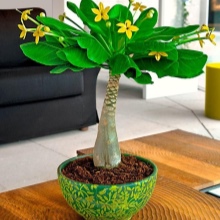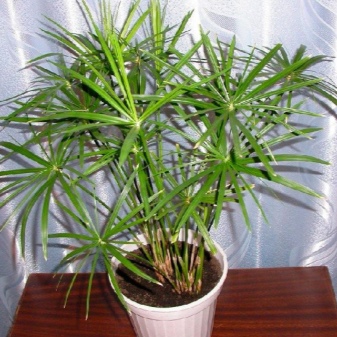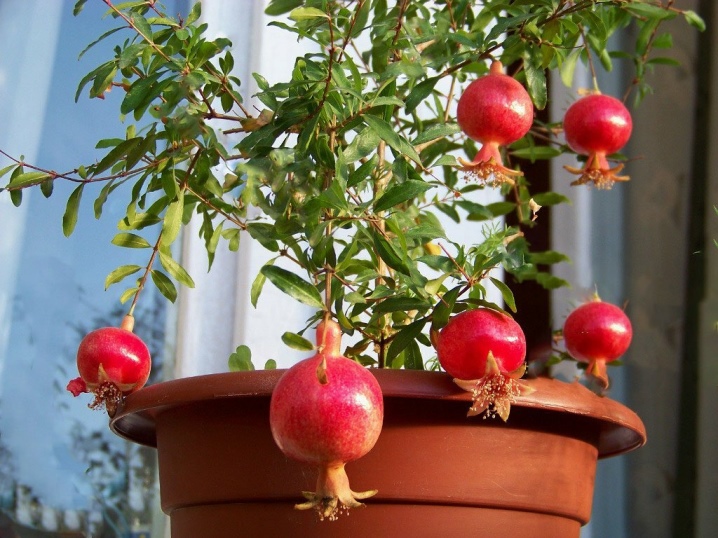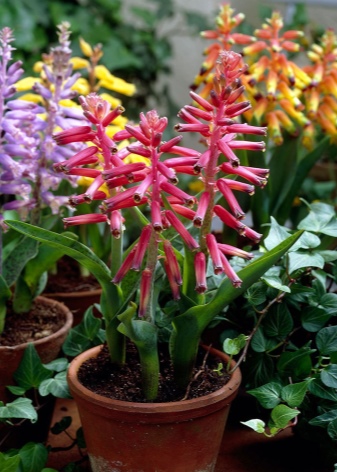The most unusual indoor plants

When it comes to decorating a house with flowers, they usually focus on mass fashion. However, not everything is so simple: in many cases it is more correct to use the most unusual indoor plants. You just need to correctly choose the right solution, taking into account both design and purely practical aspects.



What kind of fruit plants can you grow?
Growing the most unusual indoor plants from seeds or cuttings, layering, in other ways will help flower growers stand out. In addition, it is a real challenge for both beginners and even experienced amateurs. You can "exercise" on both herbaceous and shrubby and woody forms. The main thing is that there would be enough space. But it's time to get acquainted with several candidates for home breeding.
The "first number" on this list is the blue tillandsia. The representative of the bromeliad family gives original, graceful inflorescences in the shape of an ear. In the autumn months, pleasant purple flowers appear on it.
Tillandsias develop extremely slowly. In winter, they need to maintain a temperature of + 18 degrees. In all other seasons, you need to maintain the level of +25 degrees.

The arboreal spurge tirucalli is no worse. It is an evergreen succulent with twigs bending in the most intricate way. Attention: the sap of the plant, like other species of the Euphorbia family, is life-threatening.
When growing tirucalli, it is recommended to use soil mixtures for cacti and succulents. The plant needs a bright area, but partial shade is no less important.

Among the Gesneriaceae family, a naked hypocyrte stands out. The epiphytic ampel produces pretty yellowish flowers. Surrounded by juicy green leaves, they look even more attractive. The hypocyrt will bloom from the first warm days until the end of autumn.
Too dry air and significant temperature changes pose a danger to it; in winter, watering is reduced.


Adenium obese is an excellent succulent. It can produce large, graceful flowers. Their diameter is up to 0.05 m. The plant easily tolerates bright light. Even in winter, the temperature should not drop more than +13 degrees.

Flowers with interesting leaves
Bocarnea
This culture belongs to the asparagus family, in nature it inhabits stony desert and semi-desert lands.
It is believed that bokarnea first appeared in Mexico. Development is not only slow, but also uneven. The height of the trunk can reach 2 m. It is impossible to wait for the flowering of home bokarnea.
Like other tropical crops, this species can suffer from dry air and lack of light. Normally, humidity should be maintained at 50%. Propagated by bokarney seeds and cuttings. You can improve the development of the bush with the help of pinching. In the summer months, you need to water the bush every 5 days, and in the winter, the interval increases even to 12 days.

Calathea
This representative of the arrowroot family has impressive decorative properties. The genus Kalatei includes up to 130 species. In nature, it can be found in the south and in the center of the American continent. In the past, calathea leaves were used as raw materials for making baskets. But now it has become an attractive decorative deciduous plant. True, the aesthetic merits are overshadowed by high exactingness.
Calathea needs light shading. It can develop effectively at normal room temperature, as long as it is not colder than 16 degrees. During the growing season, this crop is watered abundantly. With the arrival of cold weather, the intensity of irrigation must be reduced. The air humidity is maintained at about 90%.


The dormant period for calathea is not too pronounced. It usually covers the time from September to January. Propagate culture:
- dealerships;
- cuttings;
- seeds.
With improper care, calathea can be affected by rhizoctonia. In addition to lush foliage, most of its species are distinguished by underground stems. Rosettes 0.3-0.4 m long are formed from these stems. The height of the shrub is 0.7-0.9 m. The flowering of calathea most often does not increase its aesthetic advantages.


A happy exception in this regard is the saffron species and Varshevich's calathea. Their flowers are also non-decorative, but they are surrounded by pleasant-looking bracts of different colors:
- cream;
- white;
- pink;
- orange.


Mimosa bashful
This species got its name because of the original reaction to human touch. but the plant needs careful care... The height of the bashful mimosa can be 1.5 m in nature and 0.3-0.6 m at home. It has a thorny stem, and the seeds develop inside the pods, because mimosa is part of the same family as peas and beans.
The reaction to touch and lack of light is delightful. But the plant, naturally, developed it not to amaze people, but as a means of adapting to the conditions of the tropical forest. It is impossible to breed bashful mimosa outside the home. And even at home, she needs constant warmth.
Warning: This species suffers greatly from exposure to tobacco smoke.


Oxalis
The name denotes in fact a genus of herbs known as oxalis. Oxalis is very widespread: it can be found in southern Africa, and on the American continent, and even in Europe. Moreover, oxalis has become a symbol of Ireland. In such a vast area, it is not surprising that there are 800 plant species. It combines amazing decorativeness and minimal maintenance requirements.
Oxalis will bloom from late May to early June until the onset of cold weather. The plant needs bright, but diffused light. During the growing season, the air must be warmed up at least 20 and not higher than 25 degrees. When the winter dormant period comes, the temperature is lowered to 12-18 degrees. It is necessary to protect the acid lily from scale insects, aphids and spider mites.

Caladium
This representative of the aroid family naturally inhabits the Amazonian shores. Caladium can be up to 5 m high. It is a herbaceous tuberous plant. For its large arrow-shaped leaves, Caladium is called "elephant ears". Usually foliage is painted in the following colors:
- crimson;
- silver;
- green;
- pink;
- White.

Caladium flowers have zero decorative value. Outwardly nondescript flowers are grouped into cobs. They are surrounded by a white and green bedspread. The plant plunges into winter calm for a long time, which spoils its reputation among flower growers. But such a property will turn out to be a very serious advantage for small apartments with a loggia or a wide veranda.
Attention: Caladium juice, in whatever part of the plant it is, is toxic and can cause allergies. As a consequence, culture is not good for children's rooms.
Caladiums suffer greatly from cold winds. Direct sunlight is also harmful to them. With a lack of light, the foliage will turn pale.

Cyperus
Perennial umbrella culture from the sedge family may occur under the name:
- venus herb;
- feed;
- the father's son.


Cyperus develops several tall stems. They grow from powerful roots topped with a rosette of linear leaves. In nature, the plant inhabits the rainforests of the Old and New Worlds. Its stem can grow up to 1.5-3 m. Normal care allows you to guarantee the cultivation of cyperus for up to 20 years in a row.
From 5 to 10 leaves will appear per year. Flowering occurs in the summer. Cyperus needs high humidity. If the air is dry, plant spraying is recommended. It is necessary to place the culture in shaded areas, the alternative is soft artificial lighting.
In summer, Cyperus should be placed in water. In winter, the pallets are removed and the water is drained. For cultivation, you need garden or vegetable garden land mixed with sand. You can feed Venus grass with liquid fertilizers containing nitrogen. It is transplanted every 24 months; transplanting during flowering is not allowed.


Beautifully blooming exotic plants
The exotic plants listed above do not show particularly graceful flowering. They stand out for their foliage and stems, even their roots. However, there are also cultures that will delight you with pleasant colors. Homemade citrus fruits are a good example of such plants. (pure species and hybrids equally).
True, it is not easy to achieve flowering of citrus fruits, and they are also very often attacked by parasitic insects.
Recently, the popularity of indoor pomegranate has been growing. A number of miniature varieties that can bear fruit have been bred. Moreover, these fruits are quite edible. And judging by the reviews, they are no worse than those sold in stores.

Homemade banana can also be considered a good alternative. This houseplant also bears fruit. But it must be borne in mind that some types of home bananas are fruit, and others are decorative, you will have to make a clear choice.

You can also grow pineapple in the apartment.
Attention: in order for it to bloom and bear fruit, the fruit will have to be fumigated with smoke. Planting material is taken directly from the fruit, cutting off the rosette.
You can also use:
- dates;
- olives;
- mango;
- rambutans;
- avocado;
- medlar;
- sprekelia.


A member of the sprekelia bulb family blooms in the spring months. Its foliage will surprise no one, and the bright scarlet flowers are unforgettable. Outwardly, the plant looks like an orchid. The similarity is created by 6 petals elongated in length. 3 of them are on top and 3 more on the bottom.

Lashenalia, which also produces unusual flowers, can be an attractive choice. Rather, they resemble oblong tubes of different tones. These flowers are collected in dense brushes. They are characterized by yellow, red or orange colors. "Flame" surrounded by bright green leaves - what could be more beautiful.


Unfortunately, tuberose is very rare. But this plant has a very sweet aroma. It is even used in the perfume industry. And the beauty of tuberose is extraordinary. Streptocarpus is also worth mentioning.


Unusual succulents
Corkscrew grass, aka spiral grass, is distinguished by its resistance to drought and endurance to other adverse influences. The length of caudex leaves does not exceed 0.15 m. The culture requires well-lit, warm windowsills. In winter, the temperature should not drop to more than 15 degrees. Water the corkscrew grass regularly, but not too much.
Top dressing should be done once every 14 days. At this moment, complex fertilizers are used for succulents. The soil should be rocky, with a small amount of clay, but you cannot do without clay at all. Young specimens are transplanted annually. In adult corkscrew grass, the top layer of soil is replaced once a year.

Adromiscus can be a decent replacement. This plant from the jersey family comes from southern Africa. In total, the genus Adromiscus includes at least 60 species. All of them are unpretentious, they can have various shapes and colors. Lighted places and not too active watering are preferred.

A good and close relative of the purslane is anakampseros. It is believed that its natural range is in Namibia. In total, at least 40 species of anakampseros are known. Caring for him is simple, watering should be done in moderation.

Brigamia adequately represents the family of bell-shapedThese "Hawaiian palms" were on the verge of extinction until recently.Only thanks to the efforts of ecologists and individual enthusiasts, the problem is being successfully solved. In summer, brigamia will withstand heating up to 30 degrees. In winter, the temperature should not drop below 15 degrees. Flowering occurs in September-December.

Predatory options
Among the rare domestic plants, one can also pay attention to carnivorous crops. And here it is useful to take a closer look at sarracenia. This culture comes from North America. It is found naturally in Texas, the Great Lakes region and southeastern Canada. However, most of the species are found in the southeastern United States. The trapping leaves are a funnel that resembles a hood. It grows over a special hole. Thanks to the hood, precipitation is excluded from the inside. Insects love both the color and the smell of this plant. Once under the influence of a special substance, they are digested and die. For this purpose, the plant uses protease and some other enzymes.

For the home, you can also use the tropical carnivorous nepentes. This genus with leaves resembling a water lily has more than 130 species. They are found not only in China, but also in Madagascar, the Seychelles, India and the Philippines. Most often, in nature, nepentes is a vine 10-15 m high. The main part of such crops preys on insects.

You can also pay attention to the following plants:
- genlisha;
- California darlingtonia;
- pemphigus;
- sundew;
- zhiryanka;
- vesicular aldrovand.


Beautiful examples
- The brigamy can look very good in any setting. This is how it is perceived, for example, against the background of a mesh fence and loosened earth.

- Medlar is not too inferior to the recognized leader in beauty. It is attractive even in a pot when not in bloom.

- And this is how a tall cyperus bush shows itself impressively.

For an overview of plants, see the next video.































The comment was sent successfully.